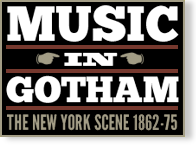Central Park Garden Concert
Event Information
Venue(s):
Central Park Garden
Proprietor / Lessee:
East 14th St at the corner of Irving Place Academy of Music
Manager / Director:
J. [manager] Gosche
Conductor(s):
Theodore Thomas [see also Thomas Orchestra]
Price: $.75
Event Type:
Orchestral
Record Information
Status:
Published
Last Updated:
4 March 2025
Performance Date(s) and Time(s)
10 Jul 1873, 8:00 PMPerformers and/or Works Performed
Citations
“The word ‘unrivalled’ has lost all meaning when used on showbills, in these days of prodigality in adjectives, except—and we believe we are safe in assuming that the exception is solitary—as we find it one the programme of ‘Theodore Thomas’s unrivalled Summer Night’s Concerts’ at Central Park Garden. Of these, his ‘Extra Grand Concerts’ of Thursday evenings are exceptionally select and excellent; and that of last night was a good example of how popular first-class instrumental music, with summer evening accompaniments, can be made. Wagner, Beethoven, Meyerbeer, Mozart, Liszt and Strauss were interpreted; and, for variety, Glinka, Bargiel and Svendsen.”
“On Thursday evening Mr. Theodore Thomas presented for the first time in this city a very interesting symphony by a composer of repute who is almost unknown to our public. Jan Svendsen, the young Norwegian violinist, has written a great deal for the orchestra, producing a variety of chamber music and setting for the full band some of the piano pieces of Bach, Schumann, and Liszt. His symphony is constructed on classical models, and is free from extravagances of all kinds, although the harmonic progressions are occasionally unduly difficult. The instrumentation is pleasing, but not very striking, and is more remarkable for the nice balance of the orchestra than for any specialty rich effects. The first movement, molto allegro, is likely to be the most popular of the four; it is distinguished for a gay and graceful fancy, which breaks out again in a rather less melodious strain in the third movement, allegretto scherzando. The other portions of the symphony, an andante and finale, are not so happy.
The audiences have not been perceptibly lessened by the warm weather, and the Garden continues to be one of the most popular and agreeable of all our Summer resorts.”

